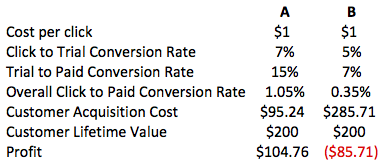The essence of marketing is to entice new and repeat customer purchases. The smaller the marketing spend and the greater the sales, the higher the profit margins. Unfortunately, margins erode over time as competitors imitate successful marketing tactics and new customer acquisitions diminish as the market become saturated with competing products. Increased competition drives up the cost of marketing in the evergreen search for new methods and new channels. The new channel that the majority of companies are failing to recognize and implement is Conversion Rate Optimization (CRO).
Let’s take the case of two hypothetical SaaS companies who both sell the same product, we’ll call them company A and company B, to demonstrate why CRO is critical to successful online marketing. Company A engages in a systematic campaign to increase conversion rates throughout their marketing funnel. Company B does not. Over the course of a year, Company A improves their conversion rate for paid channels by a factor of three (I’ve achieved this in under six months, so it’s realistic).
Here’s a quick analysis of the effect, not taking into account changing anything else:

Imagine you’re the marketer at company B.
Marketer B struggles to come up with effective marketing channels, trying tactics that are more difficult to track ROIs, like social media campaigns to gain Facebook likes and Twitter followers in order to buy time while figuring out how to make direct paid campaigns work. Frustrated by company A’s success, marketer B assumes that company A has “deep pockets” and “lots of VC funding” because how else can they possibly afford to be losing money (assuming their business economics are the same)? As you can imagine, it’s very simple to make the assumption that the business economics are the same since if you look at company B’s site, it might be a little slicker looking (or not, think Craig’s List or Amazon), but nothing jumps out as a massive competitive advantage.
Now imagine you’re the marketer at company A.
Your investments are paying off in dividends and all marketer A has to do is decide how quickly to grow and where/how else to allocate the marketing dollars. The growth gives the CEO great confidence in marketer B’s ability to acquire new customers while decreasing spend, thereby prompting the board to commit to additional funding: “if we get this money, we’ll be able to scale to 5X the size we are today!” Marketer A gets the mandate from the Board & CEO is to hit the gas on growth, upping the spend to $3/click since you’re willing to lose some money to acquire customers in the near term. At 3X the spend, marketer B can generally buy much more than 3X as many clicks, it might be 10X or more. And if marketer A continues their conversion efforts and drives down costs further, the economics only get better. CRO is a win-win.
Conclusion: CRO should be in every marketer’s toolkit.
Marketers these days have a lot of tools at their disposal, and field experts willing to “help” them with each one: SEO, SEM, various social media & viral strategies, as well as all the traditional channels such as offline advertising, PR, etc. Conversion Rate Optimization is one of the newest ones, and it’s often misunderstood (CRO is not done at random… this topic merits another blog) and ignored. Strategic conversion rate optimization is an essential marketing tool, since the effects have an amplifying effect on all other marketing activities. If you don’t employ CRO, your site suffers from a massive competitive disadvantage, a disadvantage you might not even realize you have.

